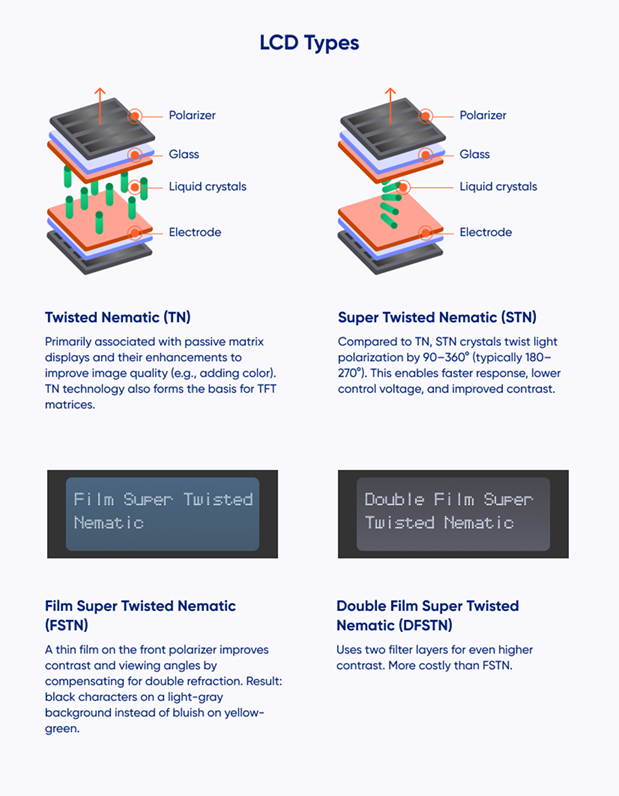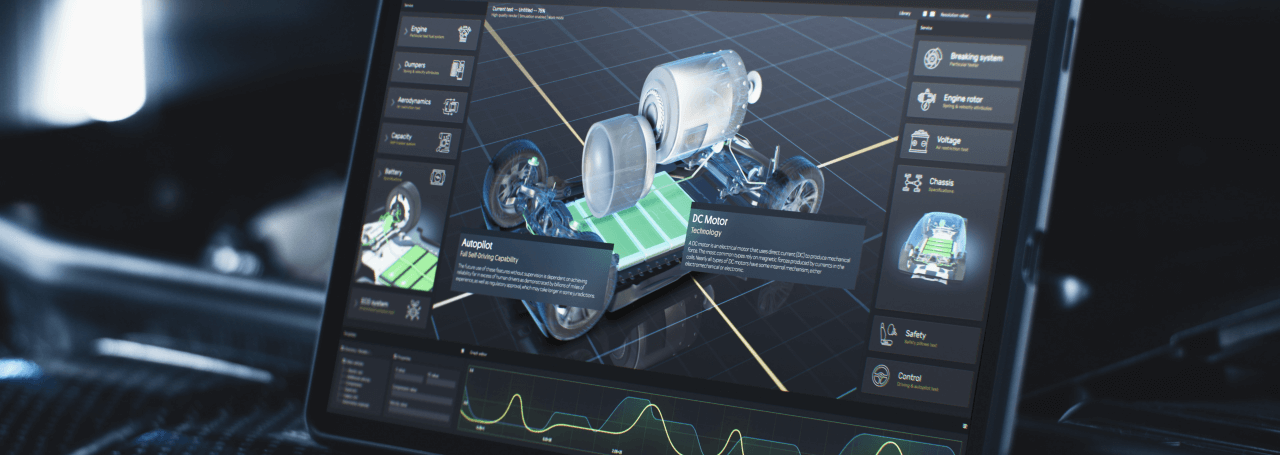In the development of monochrome displays for industrial panels, the choice between positive mode and negative mode LCDs becomes a defining factor for readability. Both modes use the same liquid crystal principles but differ in how light and polarizers interact, leading to different visual characteristics. Understanding these modes helps engineers select the best option for the specific ambient conditions, aesthetics, and application requirements.
LCD display modes: positive and negative
Liquid crystal displays rely on light modulation rather than self-emission. The orientation of liquid crystal molecules determines whether light passes through the polarizers or is blocked. By changing polarizer alignment and backlight usage, the same display cell can present itself in two distinct modes: positive or negative.
Characteristics and applications of positive mode
Positive mode is the most common configuration. Here, the background of the display appears light (gray or off-white when reflective, bright when backlit) and the characters or graphics appear dark.
Primary features:
- High readability in strong ambient light without requiring a backlight.
- Low power consumption, since reflective ambient light is often sufficient.
- Clear contrast for simple character or segmented displays
Typical applications:
- Battery-powered handheld instruments.
- Industrial devices used under bright lighting.
- Meters, thermostats, and calculators where low energy draw is essential.
All in all, positive mode suits environments where surrounding light is reliable and energy efficiency is prioritized.
Characteristics and applications of negative mode
In negative mode, the background appears dark (black or deep blue with polarizers) and the active elements—characters or symbols—are bright, usually illuminated by a backlight.
Primary features:
- Striking, high-contrast aesthetic in dim or dark environments.
- Greater reliance on backlight, resulting in higher energy consumption.
- Sometimes reduced readability in direct sunlight due to lower effective reflectivity.
Typical applications:
- Automotive dashboards and control panels.
- Consumer electronics where a modern, high-tech look is desired.
- Military or medical devices operated in low-light conditions with backlight filtering.
What does this usually look like in the decision-making process? Negative mode is selected when design aesthetics, night readability, or brand appearance are more important than minimal power draw.
LCD Technologies and Types
Beyond the simple positive/negative mode choice, the underlying LCD technology—TN (Twisted Nematic), STN (Super Twisted Nematic), FSTN (Film Super Twisted Nematic) or DFSTN (Double Film Super Twisted Nematic), and TFT (Thin-Film Transistor)—shapes contrast, viewing angles, response time, and overall readability. Riverdi emphasizes that mode selection always interacts with the chosen LCD technology: the same mode can behave differently on TN vs. STN/FSTN vs. TFT due to their distinct electro-optical characteristics.


Positive Displays
Positive displays with TN or STN technology provide high contrast under sunlight, but viewing angles are limited. In reflective versions, they require no backlight, making them ideal for energy-conscious designs. FSTN improves viewing angle and grayscale rendering, often used where a balance of cost and readability is needed.
Negative Displays
Negative displays rely on transmissive or transflective backlighting to deliver their bright-on-dark appearance. With TFT technology, negative mode is commonly used for inverted color schemes that resemble modern GUIs. These displays provide good readability in controlled lighting but may demand higher luminance backlights for outdoor use.
Character and graphic LCD modules
Character LCDs are the classic monochrome modules: 16×2, 20×4, and similar. These are available in both positive and negative modes. Positive reflective modules are common in measurement instruments, while negative modules with LED backlights are popular in consumer electronics where a dark background with glowing characters enhances user experience.
Graphic LCDs (e.g., 128×64) also come in both modes. Positive versions work well in daylight, while negative versions enable backlight-driven visuals that integrate smoothly into dark control panels.
OLED modules and color displays
Modern OLED modules naturally resemble negative mode LCDs: bright pixels on a dark background. This makes them visually similar but technically different, since OLEDs are self-emissive. Color TFT LCDs can also be configured for inverted “negative-style” interfaces, giving engineers the freedom to design UIs that mimic the aesthetic advantages of negative mode while preserving TFT performance.
To sum up, it is now clear that different monochrome LCD modes serve different design priorities. Positive mode favors energy efficiency and daylight readability, while negative mode enhances night-time visibility and modern aesthetics.
Technology choice (TN, STN, TFT, OLED) and application context ultimately guide the decision. For industrial, medical, and automotive systems, selecting the right mode is not merely about appearance but about ensuring dependable readability where and when it matters.
Still unsure which mode will fit your next project?
Don’t hesitate to contact our engineering team—supportive in every decision and phase of your R&D.
DISCOVER OUR
Whitepaper
Achieve the perfect user-display interaction with the right Touch Sensor IC. Ever faced issues with phantom touch events or certification? Boost your R&D like a pro with our Whitepaper!



